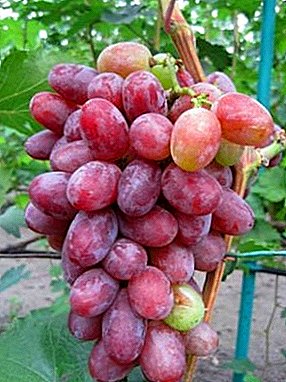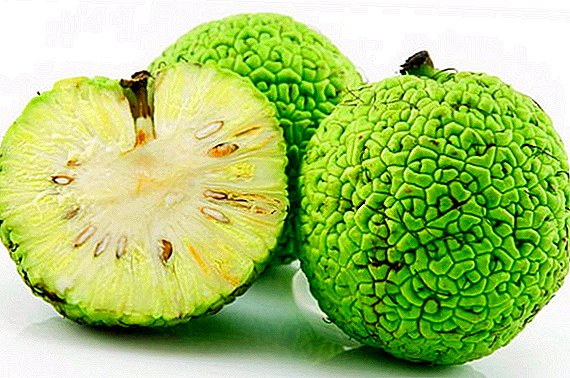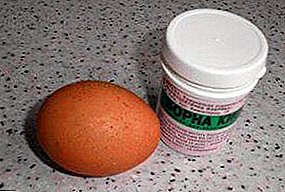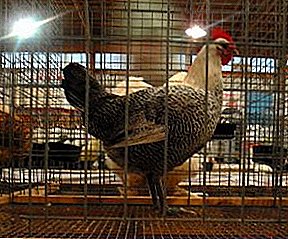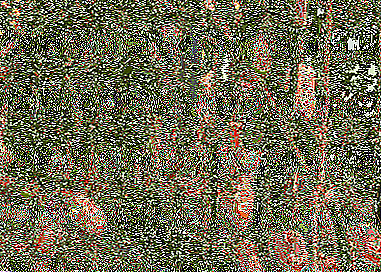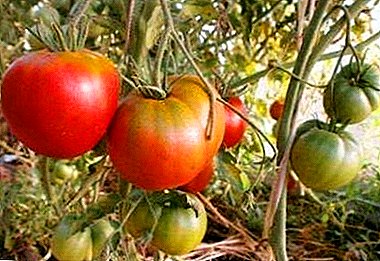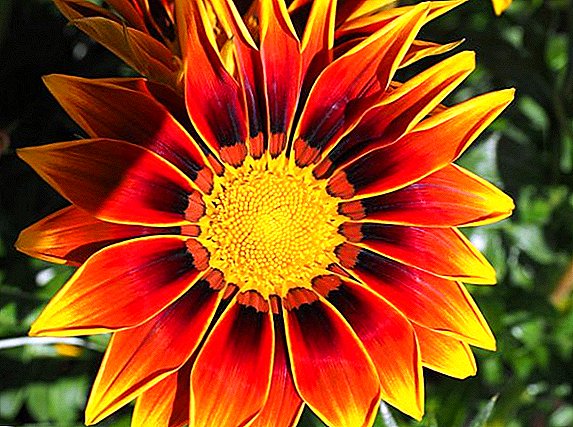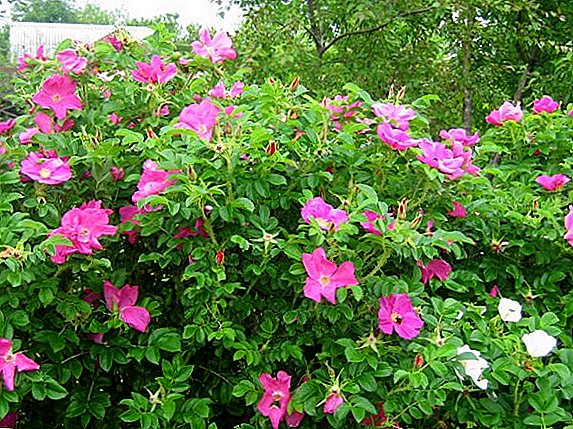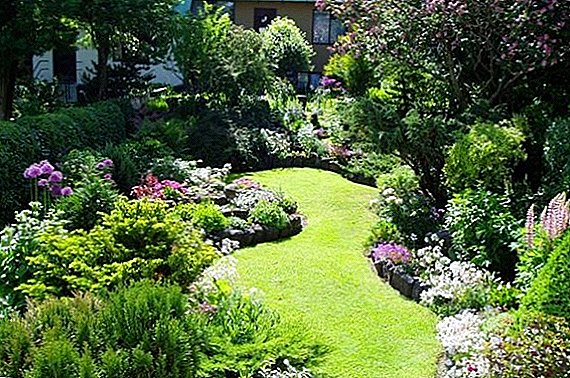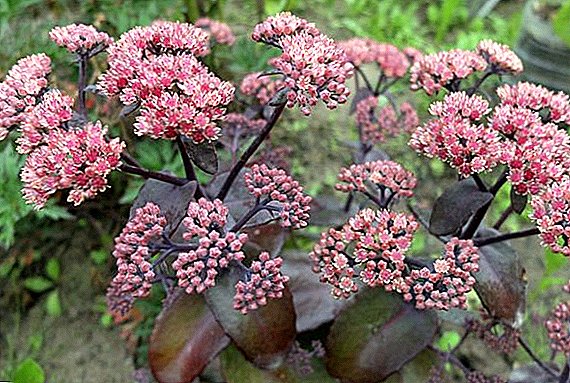 In landscape design uses a variety of different plants, among which stands out stonecrop prominent - a bright flower that will be the perfect addition to any flower bed. Let's take a closer look at exactly how this flower is used in the design, what features of its growing and reproduction in the house, and how to deal with its possible diseases and harmful insects.
In landscape design uses a variety of different plants, among which stands out stonecrop prominent - a bright flower that will be the perfect addition to any flower bed. Let's take a closer look at exactly how this flower is used in the design, what features of its growing and reproduction in the house, and how to deal with its possible diseases and harmful insects.
Botanical description
Sedum prominently, or Sedum, is a representative of the largest clandestine kind. The flower is a perennial succulent, which means that it is unpretentious and will survive in soils deprived of moisture or stony.
See the most popular forms of stonecrop.
During the flowering periods it has rich inflorescences that reach 15 cm in diameter. The colors are various: white, pink in various shades, red and even purple. Sedum looks like a small compact bush, which is easy to apply in the design of the landscape. 
Did you know? The name Sedum is derived from the Latin word "sedere", which means "to sit." This is due to the fact that there are no cuttings in the leaves of the stonecrop, and they are located very close to the shoots.The stems in the garden or at home reach 80 cm, and in nature there are shoots up to 50 cm. Sedum has fleshy, juicy, tightly covering leaves with stems. The color of the leaves may be different depending on the variety - from green to dark maroon.
The flowering period of the plant begins in July, when the inflorescences are greenish in color, and the plant itself stands out with more beautiful leaves than bright flowers. But by the autumn the inflorescences become bright and will be so even before the first frost and even snow.
Spread
The plant is of East Asian origin, and Northeast China is considered its birthplace. Sedum is widespread in Japan and Korea. In these countries, it is easy to meet in the wild. In landscape design flower is widely used throughout the world. 
Did you know? One of the first varieties of sedum is the Brilliant, which was obtained at the beginning of the twentieth century - in 1913.
Popular varieties
In the landscape design using many varieties of sedum, but the most popular of them are those that are longer than others are able to maintain a decorative look:
- "Frosti Morne". It has not only beautiful flowers, but also amazing color of leaves. They seem to be painted in white and green watercolor. It has a bud diameter of 10-15 cm and grows to 35 cm. Pale pink flowers appear from the first days of September.
- "Iceberg". This Sedum blooms with white buds, which have a diameter of up to 15 cm. The name of the variety was selected by analogy with chunks of ice, like the sedum inflorescences. The flower reaches a height of up to 35 cm, and begins to bloom in the first week of September.
- "Matron". It rightfully holds the post of one of the highest representatives of the stonecrop prominent - up to 65 cm. The stems of the plant have an interesting reddish color, and the flowers are red-pink. Paint brushes reach up to 20-25 cm in diameter. Flowering begin in August.
- Stardust. The name "stardust" literally means "star dust", because the small buds in the inflorescences of the plant resemble asterisks. The leaves of this flower have a bright green color, it blooms in September.
- "Septemberglut". The name in German means "September flame". It perfectly describes this flower - dark pink buds of the sedum seem to be lit with the lights of autumn colors. Plant height can reach up to 60 cm. The leaves are green and slightly blue. Flowering appears in September, which is clear from the name, and pleases the host right up to the first frost. Looks gorgeous in the landscape in a composition with cereals.
- "Diamond". The oldest of the classes of stonecrop prominent. It was he who served as the foundation for the creation of most other plant varieties. It has the form of a separate small bush up to 45 cm in height. Brush buds can reach up to 25 cm in diameter. Pink-carmine shade buds bloom in the last days of August or in the first decade of September. In the center of the bush buds are more dense and have a more saturated color.
- "Diamond Edge. " The leaves of this variety are brown in color, the stems are red, and the flowers complement the plant with light pink colors. The bush grows up to 50 cm in height and blooms in the period from the beginning of autumn to the first frost.
- "Charles". Like Septemberglut, it has pink inflorescences and lush green foliage with stems. It is slightly lower - up to 50 cm and has good frost resistance. In early spring, when the snow thaws, you can see almost undamaged, well-preserved flowers on the plant.
- "Variyegata". It has decorative greenish-yellow leaves, so it is more valuable before flowering. Flowers have a pink-lingonberry color. The plant grows to 60 cm and is very fond of sunlight. It starts flowering in the first weeks of autumn.
- "Purple Emperor". One of the most interesting varieties of sedum. Pink buds harmoniously overlap with the water-filled brown leaves and dark red stalks of sedum. The landscape is perfectly combined with white flowers. The height of the plant is 50 cm, it has the form of a compact bush, which does not exceed 80 cm in diameter. Flowering begins in mid-August.
- "Neon". The bush has a height of up to 60 cm. It is characterized by a change in the color of the leaves - in the summer they are gray-green, and in winter they become red-bronze. The color appears in mid-August and lasts until the end of October. Buds have a lilac-pink color.
- "Xenoks". Known as the most "red" representative sedumov. Stems, flowers, leaves - all visible parts of the plant have bright purple hues. Small bush - up to 35 cm.
- "Carmen". Flower buds have a light pink color, and the leaves shine green with thin red veins. Stems complement the ensemble bright burgundy color. Grows dense bush up to 50 cm in height and 30 cm in diameter. Blossoms from mid-August to early October.
- "Autmn Fire". In translation, the name means "autumn fire". Stems rise to 50 cm and have a fresh green color. The leaves are also green with a gray tint. Flowers have a noble copper-pink color.
- "Portmans Pride". Sedum reaches a height of 60 cm. The leaves have a purple color, and flowers - delicate pink. Shows the color begins in September.
- "Red Cowley". Combines purple foliage and bright red buds. It grows up to 50 cm.
- Rosteteller. It has oval-shaped green leaves with infrequent teeth along the edges. The flowers are large, on high peduncles. Flowers have a lingonberry-pink color. In height reaches 40-60 cm. It blooms in May.

















The decoration for your garden will be sedum, which will delight with its flowering almost all summer.
Application in design
The prominent prominent is distinguished by its brightness and unpretentiousness to the conditions, and this is what gains the attention of landscape designers. It will look equally beautiful in a rocky garden, in a flower bed, and in a curb. Sedum well complement the picture as a country mansion, and a village house.
There are the following options for placing stonecrop in the landscape:
- Rock garden Sedum as a succulent will perfectly fit into a stone design. It will serve as an excellent complement to the planes, the slopes of the mountains, as well as the alpine hills. The use of stones will help to pay special attention to the amazing beauty of stonecrop.
- Border. For these purposes, it is better to choose the stonecrop varieties with the highest growth. This plant can serve as a barrier to the separation of certain functional parts of the site. It will be especially beautiful to use several high grades of sedum so that the decor shines with bright colors.
- Rockery It can even be placed in a small garden. Different varieties of plants are planted in vessels of stone or wood. Later, this decor can even be moved around the site to create a more favorable composition.
- Flowerbed. In a flower bed you can arrange both high and undersized varieties of stonecrop. Since these plants are very resistant to the external environment, they are not afraid of even the polluted atmosphere of big cities.
It will be useful for you to learn how to make a flowerbed of stones and rockeries with your own hands, what border flowers can decorate the site and how to decorate the flowerbed harmoniously.
It is best to place the bushes of the sedum in the group. Its solitary bushes do not look as impressive as group plantings, especially if you pick plants of different colors. The area for breaking the flower bed should be chosen large enough. Also stonecrop prominent can decorate a group of other types of succulents.

Important! Do not place the stonecrop visible in wet areas and low areas where water accumulates - this can cause the death of the plant.
Undesirable is the placement of sedum near large bushes or fruit plants. They can give an excessive shadow on the plant, and the foliage that will fall from the trees, will retain moisture in the ground under the stonecrop. Such conditions can lead to the development of diseases and the appearance of insects.
Growing at home
Since Sedum is a submissive plant, unpretentious and patient with external weather conditions, it is easy to grow at home. However, it is useful to know about the conditions of its maintenance, care, features of reproduction and means of combating insects and diseases.
Conditions of detention
The pot for a stonecrop prominent is chosen not very deep, but rather wide, since its roots go deep and more often grow on the surface of the soil. 
Important! The plant needs good drainage inside the pot.
This flower is very fond of light, so the apartment will need to choose the sunniest south window sill. If this is not possible, it will be necessary to equip him with additional lighting.
Sedum responds well to warm temperatures from spring to winter. In winter, in order for the plant to become dormant, it is necessary to provide it with a temperature no higher than +7 ° C. If it is warmer indoors in the winter, additional lighting will be needed, otherwise the stonecrop visible will continue to grow and stretch noticeably.
Soil and fertilizer
The soil is picked up nutritious. Well suited for Sedum soil for decorative leafy plants, which is easy to find in a specialty store. It can be made independently by mixing equal shares:
- sand;
- sod land;
- garden land.
 Sedum in landscape design
Sedum in landscape designImportant! Do not over feed plants with humus and fertilizers - the inflorescences will become too large, which can lead to brittle stems, and the bush will become too wide and sloppy.
Dense soil is not suitable for this plant - you need to make sure that it does not have clay. If the earth is rich in clay, it is necessary to dilute it with peat, sand, vermiculite or perlite. The acidity of the soil is slightly acid or neutral.
Watering and moisture
This flower does not require strong moisture. If the summer was very dry and hot weather, you can from time to time spray the plant with water. In the summer it is watered only 1 time per month. To do this, a 2-liter container with a flower will need only 100 g of warm soft water. In winter, the plant is best placed on the open terrace and continue watering as usual.
In the conditions of open ground, stonecrop visible water only for the first time after landing in the ground. Then he will be able to regulate the amount of moisture required. Watering may be necessary only in the period of prolonged lack of rain.
Did you know? In nature, there is a sedum variety "Morgana". If a person eats at least one of his leaf, he is threatened with severe poisoning, which will be accompanied by diarrhea, vomiting and other symptoms. This dangerous variety is not used for decorative purposes.
Breeding
Sedum is easily propagated by seed and vegetatively. The main thing - to choose the best option for its owner and follow all the instructions for reproduction.
Seeds  The method of reproduction using seeds is used less frequently than vegetative. This process is more time consuming and time consuming. Moreover, the grade of sedum is not transmitted during reproduction by the seed method.
The method of reproduction using seeds is used less frequently than vegetative. This process is more time consuming and time consuming. Moreover, the grade of sedum is not transmitted during reproduction by the seed method.
To multiply the stonecrop visible seed, you must take the following steps:
- Sow the seeds in a container or pot with nutrient soil. This should be done in March. To improve germination, the container is covered with glass.
- Put the pot in a cool room (about +7 ° C). This may be a refrigerator, basement, glazed balcony, vestibule.
- A few days later the flower must be brought into the heat and wait for seed germination.
- When two true leaves appear on the plant, it is necessary to pick it up and plant seedlings in separate cups. Seated 1-3 pieces in one cup.
Vegetative
There are several types of vegetative reproduction of sedum:
- bush division;
- grafting;
- shoots;
- air layouts;
- vaccinations.
The method of dividing the bush is used only with adult plants - at least 4 years old. The sequence of actions during reproduction:
- Dig up the sedum from all sides and carefully remove from the soil.
- Divide the shrub shears in such a way that the growth point and roots can be seen in each separate part.
- Sprinkle cuts with charcoal.
- Drain the plants for several hours, and then land in the soil.

Important! The division of the bush is carried out in the first weeks of summer, so that it can get a good root system by the fall.
With the help of grafting, stonecrop can be propagated during all the warm months. Method:
- Green cuttings are cut with sharp shears in such places of the sedum, where it does not damage the appearance.
- Cut cuttings placed in water or added dropwise immediately into a suitable soil. In a few weeks, the cuttings will give their own roots.
- Daily watering prikopannyh cuttings, monitor soil moisture.
 If a plant has sprouts, it is tilted and pinned to the ground. After a month in the place of contact of the flower with the ground roots will appear. Some types of sedum are airborne. When they reach such a length that they can touch the ground, the layers will take root. It is possible to instill stonecrop in the spring or in dry weather. For this, the stock is tightly connected with the graft and this structure is fixed for a month. If after this the plants have not grown together, you can try again.
If a plant has sprouts, it is tilted and pinned to the ground. After a month in the place of contact of the flower with the ground roots will appear. Some types of sedum are airborne. When they reach such a length that they can touch the ground, the layers will take root. It is possible to instill stonecrop in the spring or in dry weather. For this, the stock is tightly connected with the graft and this structure is fixed for a month. If after this the plants have not grown together, you can try again.
Sedum prominently known not only for its decorative properties, it is also used in traditional medicine. Other types of healing properties also have a purple stonecrop and a large stonecrop.
Pruning
Pruning may be decorative. To do this, prune all old, too long or damaged stems. Pruning should be carried out in adulthood. When the plant reaches 5 years old, you need to rejuvenate it by dividing the bush. It is desirable to do it in the spring, but it is possible and in the fall. Roots grow quickly in Sedum, therefore it is necessary to limit its growth in time, while cutting new shoots. Also, this problem can be solved by prikopat space around the plant, put slate, tile or stones.
Wintering
In preparing the stonecrop prominent for wintering, pruning must be carried out. Although it is frost-resistant, its green shoots die. Only the roots and growth points that are located at ground level will survive after winter. It would be advisable to prune all the green branches of the flower, and carefully cover the growth points with opal foliage. 
Important! In order to cause fewer injuries, for pruning use a sharp shears, which cut off the branches at a level of 2 centimeters from the ground.
Possible difficulties in growing
Difficulties in growing Sedum actually not observed, since this plant is very tenacious, it is very difficult to get rid of it. A flower can die only if its root system starts to rot, and for this it needs to be watered daily. However, if at least one escape of stonecrop prominent remained intact, the plant will be reborn.
Pests, diseases and prevention
Sedum is highly resistant to pests and diseases. However, if it is abundantly watered or overfed with fertilizers, it can become ill or acquire pests.
The plant can be attacked by such insects and diseases:
- caterpillars of real sawflies;
- powdery mildew;
- aphid;
- spider mite;
- green leafworm;
- May Khrushchev;
- fungus.
 Aphids on plants. You can beat them by using black currant insecticides ("Tanrek"). Stonecrop will help save Actellic from tracks. If the leaves and stems of the plant were covered with brown spots, it means that a fungus appeared that can be managed only by destroying the plant in the fire. To protect the Mayan Khrushchev from mid-April, the crown, trunk, and root collar of the stonecrop are prominently sprayed with special means, such as Prestige and Antichrush, and repeat the process every 40-50 days of the growing season. To protect the flower from diseases and fungi, fungicides are used - "Skor", "Maxim", "Switch", "Horus". As a preventive measure, in spring and summer Sedum is sprayed with insecticides - "Aktara", "Match", "Angio".
Aphids on plants. You can beat them by using black currant insecticides ("Tanrek"). Stonecrop will help save Actellic from tracks. If the leaves and stems of the plant were covered with brown spots, it means that a fungus appeared that can be managed only by destroying the plant in the fire. To protect the Mayan Khrushchev from mid-April, the crown, trunk, and root collar of the stonecrop are prominently sprayed with special means, such as Prestige and Antichrush, and repeat the process every 40-50 days of the growing season. To protect the flower from diseases and fungi, fungicides are used - "Skor", "Maxim", "Switch", "Horus". As a preventive measure, in spring and summer Sedum is sprayed with insecticides - "Aktara", "Match", "Angio".
Important! When signs of the disease appear on one of the plants of the flower bed, it is faster and more beneficial to get rid of it than to cure it. This will help prevent the disease of other bushes.
Sight prominent - unpretentious and very beautiful succulent. The bright colors of its buds will help to create a unique autumn landscape in the yard of a country house or on the windowsill of an apartment. With proper care and constant care, Sedum will be pleasing to the eye for many years.


